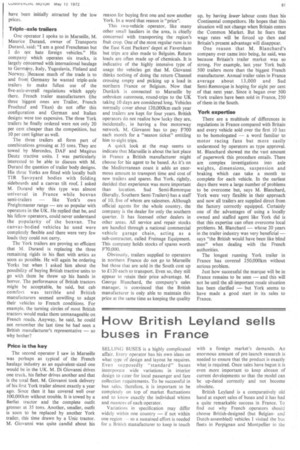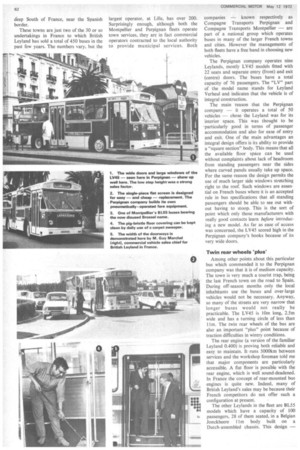How British Leyland sells buses in France
Page 67

Page 68

Page 69

If you've noticed an error in this article please click here to report it so we can fix it.
SELLING BUSES is a highly complicated affair. Every operator has his own ideas on what type of design and layout he requires. Even supposedly "standard" buses incorporate wide variations in interior design to cater for local passenger and fare collection requirements. To be successful in bus sales, therefore, it is important to be completely on top of market fluctuations and to know exactly the individual whims and nuances of each operator.
Variations in specification may differ widely within one country — if not within one region --so a sustained effort is needed for a British manufacturer to keep in touch with a foreign market's demands. An enormous amount of pre-launch research is needed to ensure that the product is exactly what is required. Once sales have begun it is even more important to keep abreast of current developments so that the model can be up-dated correctly and not become obsolete.
British Leyland is a comparatively old hand at export sales of buses and it has had a quite remarkable success in France. To find out why French operators should choose British-designed (but Belgianand Dutch-assembled) vehicles I visited the bus fleets in Perpignan and Montpellier in the deep South of France, near the Spanish border.
These towns are just two of the 30 or so undertakings in France to which British Leyland has sold a total of 450 buses in the past few years. The numbers vary, but the largest operator, at Lille, has over 200. Surprisingly enough, although both the Montpellier and Perpignan fleets operate town services, they are in fact commercial operators contracted to the local authority to provide municipal services. Both companies known respectively as Compagne Transports Perpignan and Compagne Transports Montpellier — are part of a national group which operates buses in many of the larger French towns and cities. However the managements of both fleets have a free hand in choosing new vehicles.
The Perpignan company operates nine Leylands, mostly LV45 models fitted with 22 seats and separate entry (front) and exit (centre) doors. The buses have a total capacity of 76 passengers. The "LV" part of the model name stands for Leyland Verheul and indicates that the vehicle is of integral construction.
The main reason that the Perpignan company it operates a total of 50 vehicles — chose the Leyland was for its interior space. This was thought to be -particularly •good in terms of passenger accommodation and also for ease of entry and exit. One of the main advantages an integral design offers is its ability to provide a "square section" body. This means that all the available floor space can be used without complaints about lack of headroom from standing passengers near the sides where curved panels usually take up space. For the same reason the design permits the use of much larger side windows stretching right to the roof. Such windows are essential on French buses where it is an accepted rule in bus specifications that all standing passengers should be able to see out without having to stoop. This is the sort of point which only those manufacturers with really good contacts learn before introducing a new model. As far as ease of access was concerned, the LV45 scored high in the Perpignan company's books because of its very wide doors.
Twin rear wheels 'plus' Among other points about this particular bus which commended it to the Perpignan company was that it is of medium capacity.
The town is very much a tourist trap, being the last French town on the road to Spain.
During off-season months only the local inhabitants use the buses and over-large vehicles would not be necessary. Anyway, so many of the streets are very narrow that longer buses would not really be practicable. The LV45 is 10m long, 2.5m wide and has a turning circle of less than I lm. The twin rear wheels of the bus are also an important "plus" point because of traction difficulties in wintry conditions.
The rear engine (a version of the familiar Leyland 0.400) is proving both reliable and easy to maintain. It runs 5000km between services and the workshop foreman told me that major components are particularly accessible. A flat floor is possible with the rear engine, which is well sound-deadened. In France the concept of rear-mounted bus engines is quite new. Indeed, many of British Leyland's sales may be because their French competitors do not offer such a configuration at present.
The other Leylands in the fleet are BL55 models which have a capacity of 100 passengers, 28 of them seated, in a Belgian Jonckheere llm body built on a Dutch-assembled chassis. This design — rather older than the LV45 — is due to be phased out in 1974. Until recently it was sold in France under the Brossel name, which was what all British Leyland's commercial vehicles were called there. Now, all French commercial vehicle sales are made through a company called SA Aveling-Barford Leyland. Quite why that name — derived from the least known British Leyland subsidiary making construction equipment in Lincolnshire — was chosen, I do not know.
The Perpignan fleet — the rest of which consists of Saviem and Berliet buses — has placed a provisional order for six more LV45s. The company operates 14 routes and buses average 180km per day each. Total distance covered is about 5000km a day. The undertaking builds its own pneumatically operated ticket equipment.
M. J. F. Georget, transport manager of the Montpellier fleet, has taken delivery of 14 Leylands so far, most of them BL55s under the Brossel name plate. Most of these are fitted with the optional 0.680 engine. The 70 vehicle fleet — there are Saviem, Berliet and Citroen buses as well — operates eight routes within a 15km radius of the town. Over 50,000 passengers are carried each day and every bus covers something like 200km each day.
The reasons for buying Leylands are not dissimilar to those put forward down the road at Perpignan. Capacity was thought to be good in relation to overall size and, although the Saviems can carry more, passengers in the Leylands can see out easily. This is evidently a very strong sales feature. The only two extras which the company specified were fresh air ventilation — considered essential for that famous South of France weather — and a novel pig-bristle floor covering. This is a discovery of M. Georget's which, he claims, looks good, wears well and can be kept clean easily. In fact, cleaning is a little more expensive than with conventional materials — a vacuum clean is given daily and shampoo is used every fortnight — but the enhanced wearing characteristics are thought to justify this. Certainly it bestows a semiluxury appearance, unusual in urban buses, on the vehicle.
Both the BL55s and the few LV45s which M. Georget has recently added to the fleet, are of a two-door layout. Three doors would be better for loading and unloading times, he said, but fare dodging would then be too difficult to stop with a one-man, non-flat-fare system.
I was particularly interested in the way these private companies operate services which, in England, would be operated by the local authority. M. Georget was good enough to explain the system to me. His company was formed in 1968. Before that the Montpellier municipality had operated its own vehicles -many of which are still in the fleet — but after these had begun to make regular losses they decided to opt out, partly owing to political pressure.
Accordingly they invited M. Georget's group to form a company, which it did, and buy the vehicles. In the past two years a degree of route rationalization has taken place, with the loss of four services from the original 12. The eight remaining ones are now operated at a higher frequency.
The procedure for fare increases seems a little complicated but appears to work amicably enough. M. Georget has to apply to both the prefecture (the police authority) and to the town council for permission. Rises have been confined to the average increase in the cost of living — about eight per cent per annum — for the past few years and have not met with any opposition.
Bright future Clearly, British Leyland's future sales prospects in the French bus industry are going to depend heavily upon two vehicles: the LV45 and the Leyland National. A talk with M. Guy Marchal, British Leyland's French commercial vehicle sales chief, revealed that the future is bright. Not only is the LV45 gaining in popularity among operators -chiefly at the expense of French manufacturers who have no effective competitor — but there is good news on the National, too.
The National is due to be launched in France this autumn and present indications are that it will sell for about F150,000 — about the same as the BL55 but F10,000 less than the equivalent Mercedes-Benz model, the 305. Admittedly, the cost of optional extras is still not known, but even so the price is evidently going to be very competitive. (Incidentally British Leyland • has calculated that the prices of vehicles it exports to France will benefit only by about two per cent when Britain joins the Common Market. Cost of spare parts will be drastically reduced, however.) M. Marchal told me that he thinks that for the Leyland National to be really successful in France a number of modifications may have to be made. These include wider doors (on the National they are 1.2m but French operators prefer 1.45m) and windows that reach higher than at present, to allow better visibility for standing passengers. There may also be a reluctance on the part of some French operators to accept turbocharged engines, which have a very bad name there.
However, M. Marchal does not see any serious obstacle which will prevent the National adding to British Leyland's already extensive penetration of the French bus market. Undoubtedly its strongest competitor will be the LV45 (which will still be available after the National arrives), so either way the group should not lose out on this valuable business.
















































































































































































































